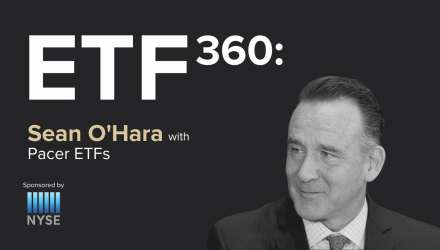For this week’s episode of ETF 360, ETF Trends CEO Tom Lydon and CIO Dave Nadig spoke with Sean O’Hara, President of Pacer ETF Distributors, who discusses the prospect of inflation, rising rates, and where to go fro real income and returns.
Watch the Full ETF 360 Episode Here:
As Lydon notes, investors are concerned if the ’40’ in the 60/40 is dead. As far as what can be done, O’Hara notes the recent launch of a few Pacer funds that employ a strategy designed to provide 3 and 4 times the dividend yield of the S&P 500 without using leverage.
Those two funds are the Pacer Metaurus US Large Cap Dividend Multiplier 300 ETF (TRPL) and the Pacer Metaurus US Large Cap Dividend Multiplier 400 ETF (QDPL). Both have fairly straightforward strategies. Looking at QDPL, 88% of the portfolio would be invested in the S&P 500, while the other 12% would be invested in T-bills that would be used as collateral to own futures contracts on future dividends of the S&P 500. That would allow for a current yield in this environment of about 5.3%, and about 65% of that will be not taxable income to the end investors.
As O’Hara states, “When you start to calculate the net after taxes, it’s a very attractive idea and opportunity in this environment where we’re looking for yield anywhere we can get it, and the traditional sources aren’t giving it to us.”
Regarding the 60/40, O’Hara notes that if there’s money being carried away from the bond portfolio and into the equity portfolio because of a lack of return, these funds are a way to achieve this with a little less equity exposure.
Looking at the futures market Pacer is participating in to generate that income, O’Hara notes that it is a huge market to consider, with many big institutional investors using it to get access to dividend futures. One of the sellers on this market is the structured note players. They typically serve as the price-only side. With that in mind, there are buyers and sellers on both sides, with a lot to consider given the size of the market.
Considering the longer time horizon out there for investors in a potentially rising rate environment, O’Hara has essentially made the argument that the Pacer funds can allow for taking the 60/40 with emphasis on the ’40’ and finding there won’t be as much volatility as with the S&P 500, and still getting more than 5% based on current dividends. Additionally, there’s no leverage or counterparty risk, which is important.
O’Hara reiterates, “There’s no leverage in their strategy, generating a very competitive and attractive current yield to the investor who’s looking to have that part of their portfolio provide what it normally has been providing for the last 20 years, which is an attractive overall part to the total return.”
For more ETF 360 videos, visit our ETF 360 Channel.
